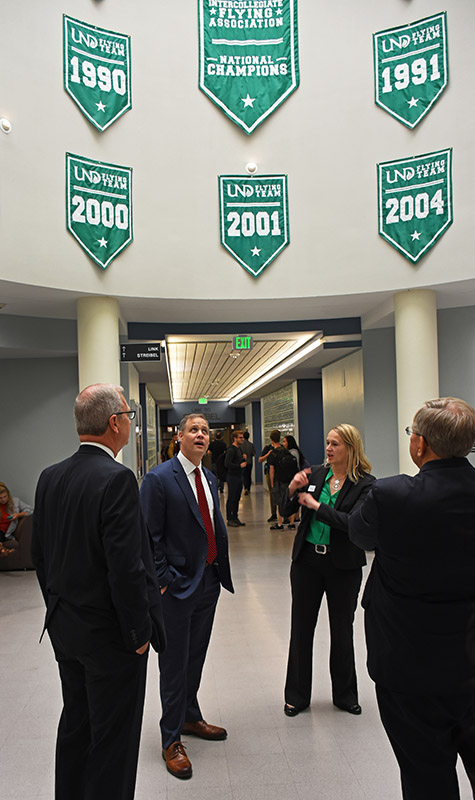06 Sep NASA Administrator Jim Bridenstine lauds UND’s aerospace research

NASA Administrator Jim Bridenstine visited the UND John D. Odegard School of Aerospace Sciences on Wednesday to learn about research being conducted there for the agency and to discuss future collaborations. Photo by Patrick C. Miller/UND Today.
In a visit to UND on Wednesday, NASA Administrator Jim Bridenstine commended the work being done at the John D. Odegard School of Aerospace Sciences and called its research “second to none.”
“The University of North Dakota is delivering — on behalf of NASA — technology that is helping us understand the earth, helping us understand the earth’s atmosphere, helping us better predict weather events and the climate,” Bridenstine said. “Beyond that, the University of North Dakota is helping us with human space flight.”
Following meetings with UND faculty and students and a tour of the aerospace school’s facilities, Bridenstine said, “What happens here enables us to do more than ever before. UND will be part of NASA’s future space exploration efforts.”
Uber to the moon
During his visit, Bridenstine explained his plan to move human space exploration missions to the moon and Mars forward by ending NASA’s practice of purchasing and owning hardware. Instead, the agency will buy services from private companies that collaborate with universities such as UND. He compared it to hiring an Uber for a trip to the moon.

At the NASA-funded Inflatable Mars/Lunar Habitat, Jim Bridenstine (right) and Sen. Kevin Cramer (center) are greeted by a student wearing a space suit designed by Pablo DeLeon (left), head of the UND Human Spaceflight Laboratory. Photo by Patrick C. Miller/UND Today.
“We want to encourage universities to do what they’re good at doing — providing basic research to the private companies we will contract with,” he said. “What’s unique about university settings is that you can get scientists and engineers in the same room to collaborate in real-time in ways that don’t happen in industry — you don’t get an optimized solution. “
U.S. Sen. Kevin Cramer, R-N.D., arranged for Bridenstine’s visit to UND and accompanied him on the visit. Cramer said he and Bridenstine, who’s from Oklahoma, became friends when they were both elected to the U.S. House in 2012. They were cubicle neighbors before being assigned offices and also served for a time together on the House Committee on Science, Space and Technology.
“When Jim was appointed NASA administrator last year, I couldn’t have been more delighted,” Cramer said.
UND’s bench of talent

During a tour of UND’s aerospace school, NASA Administrator Jim Bridenstine, a former U.S. Navy pilot, pauses to view banners the University’s student pilots have won in national flight competitions. Photo by Patrick C. Miller/UND Today.
A former U.S. Navy pilot, Bridenstine noted that some pilots he flew with were graduates of UND’s aerospace school. He said universities provide NASA with “a wealth of knowledge” and students who are “a bench of talent for decades.” He also recognized UND’s efforts to help deal with the global shortage of pilots by providing aviation training for students “who are ready to go on Day One.”
During a breakfast in Robin Hall, Bridenstine was welcomed to UND by President Joshua Wynne, Tom DiLorenzo, provost and vice president for academic affairs, and Paul Lindseth, dean of the aerospace school. Aerospace faculty members presented briefings on space studies and atmospheric sciences projects at UND related to ongoing NASA programs, as well as NASA-funded EPSCOR grants and a STEM outreach program for K-12 students.
When Bridenstine asked about UND’s ability to collaborate with industry, DiLorenzo noted that the University had just this week signed an agreement with the North Dakota Department of Commerce and the Bank of North Dakota that will assist in commercializing research. He said this provides the UND with a flexible policy to commercialize intellectual property.
“That’s fantastic,” Bridenstine replied.
NASA connections
A tour of UND aerospace facilities included unmanned aircraft systems (UAS) active learning, aircraft and spacecraft simulators, the Inflatable Mars/Lunar Habitat (IMLH), the altitude chamber, the atmospherium, the Human Spaceflight Lab, the NASA Space Grant office and air traffic control simulators.
During a town hall meeting in Clifford Hall, faculty and students asked Bridenstine questions about topics such as how NASA plans to handle human factors related to deep space exploration and how it plans to avoid lapses in funding that have caused decades of pauses between manned space flights. Bridenstine cited UND’s Inflatable Mars/Lunar Habitat and space suit designs as examples of research that will assist NASA with solving issues related to deep-space missions that will last years. The moon, he explained, will serve as the proving ground for missions to Mars.

At UND’s altitude chamber, Bridenstine (center) shares a story about his experience as a pilot with Sen. Kevin Cramer and Elizabeth Bjerke, aerospace associate dean. Photo by Patrick C. Miller/UND Today.
“We want to be able to have sustainability on the moon with the purpose of learning how to live and work on another world and then go to Mars. That Mars analog (IMLH) that’s being done here at the University of North Dakota is going to be critical for us in the future.”
Bridenstine also noted the importance to NASA of space suits being designed by Pablo DeLeon, who heads the UND Human Spaceflight Laboratory.

Following a town hall meeting in Clifford Hall, Bridenstine posed for selfies with UND aerospace students. Photo by Patrick C. Miller/UND Today.
“One of the amazing capabilities here is the space suits,” Bridenstine said, describing how they enable astronauts to live and work in the vacuum of space in high-radiation environments and extreme temperatures. “Now, because of the good work of the University of North Dakota, we’re going to have some capabilities and technologies that enable us to walk on another world. They are amazingly complex space suits; every space suit is a space ship.”
To view a short UND Aerospace video of Bridenstine’s visit, click here.


